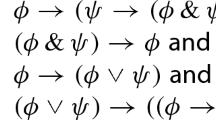Abstract
This article provides additional evidence of the value of using an automated reasoning program as a research assistant. Featured is the use of Bill McCune's program OTTER to find proofs of theorems taken from the study of Moufang loops, but not just any proofs. Specifically, the proofs satisfy the property of purity. In particular, when given, say, four equivalent identities (which is the case in this article), one is asked to prove the second identity from the first, the third from the second, the fourth from the third, and the first from the fourth. If the proof that 1 implies 2 does not rely on 3 or 4, then by definition the proof is pure with respect to 3 and 4, or simply the proof is pure. If for the four identities one finds four pure proofs showing that 1 implies 2, 2 implies 3, 3 implies 4, and 4 implies 1, then by definition one has found a circle of pure proofs. By finding the needed twelve pure proofs, this article shows that there does exist a circle of pure proofs for the four equivalent identities for Moufang loops and for all orderings of the identities; however, for much of this article, the emphasis is on the first three identities. In addition — in part to promote the use of automated reasoning programs and to answer questions concerning the choice of options — featured here is the methodology that was employed and a discussion of some of the obstacles, some of which are subtle. The approach relies on paramodulation (which generalizes equality substitution), on demodulation, and — so crucial for attacking deep questions and hard problems — on various strategies, most important of which are the hot list strategy, the set of support strategy, and McCune's ratio strategy. To permit verification of the results presented here, extension of them, and application of the methodology to other unrelated fields, a sample input file and four proofs (relevant to a circle of pure proofs for the four identities) are included. Research topics and challenges are offered at the close of this article.
Similar content being viewed by others
References
Boyer, R. S. and Moore, J S.: A Computational Logic Handbook, Academic Press, New York, 1988 (also Web information http://www.cli.com/software/nqthm/obtaining.html).
Bruck, R. H.: A Survey of Binary Systems, Springer-Verlag, Berlin, 1971.
Chein, O.: Moufang loops of small order, Memoirs Amer. Math. Soc. 13(1, No. 197) (January 1978).
Chein, O., Pflugfelder, H. O., and Smith, J. D. H.: Quasigroups and Loops: Theory and Applications, Heldermann Verlag, Berlin, 1990.
Fenyves, F.: Extra loops I, Publicationes Mathematicae Debrecen 15 (1968), 235–238.
Fenyves, F.: Extra loops II, Publicationes Mathematicae debrecen 16 (1969), 187–192.
Kunen, K.: Private communication, 1994.
McCharen, J., Overbeek, R., and Wos, L.: Complexity and related enhancements for automated theorem-proving programs, Computers and Mathematics with Applications 2 (1976), 1–16.
McCune, W. and Wos, L.: Application of automated deduction to the search for single axioms for exponent groups, in A.Voronkov (ed.), Logic Programming and Automated Reasoning, Lecture Notes in Artificial Intelligence, Vol. 624, Springer-Verlag, New York, 1992, pp. 131–136.
McCune, W.: OTTER 3.0 Reference Manual and Guide, Technical Report ANL-94/6, Argonne National Laboratory, Argonne, IL, 1994.
Moufang, R.: Zur Struktur von Alternativkörpern, Math. Ann. 110 (1935), 416–430.
Padmanabhan, R. and McCune, W.: Automated reasoning about cubic curves, Computers and Mathematics with Applications (special issue on automated reasoning) 29(2) (January 1995), 17–26.
Padmanabhan, R. and McCune, W.: Single identities for ternary Boolean algebras, Computers and Mathematics with Applications (special issue on automated reasoning) 29(2) (January 1995), 13–16.
Pflugfelder, H. O.: Quasigroups and Loops: Introduction, Heldermann Verlag, Berlin, 1990.
Wos, L.: Automated Reasoning: 33 Basic Research Problems, Prentice-Hall, Englewood Cliffs, NJ, 1987.
Wos, L.: Meeting the challenge of fifty years of logic, J. Automated Reasoning 6(2) (1990), 213–222.
Wos, L., Overbeek, R., Lusk, E., and Boyle, J.: Automated Reasoning: Introduction and Applications, 2nd edn, McGraw-Hill, New York, 1992.
Wos, L.: Automated reasoning answers open questions, Notices of the AMS 5(1) (January 1993), 15–26.
Wos, L.: The kernel strategy and its use for the study of combinatory logic, J. Automated Reasoning 10(3) (June 1993), 287–343.
Wos, L.: The power of combining resonance with heat, J. Automated Reasoning, accepted for publication.
Wos, L.: The resonance strategy, Computers and Mathematics with Applications (special issue on automated reasoning) 29(2) (February 1995), 133–178.
Wos, L.: Searching for circles of pure proofs, J. Automated Reasoning, accepted for publication.
Wos, L.: The Automation of Reasoning: An Experimenter's Notebook with OTTER Tutorial, accepted for publication by Academic Press, 1996.
Author information
Authors and Affiliations
Additional information
This work was supported by the Mathematical, Information, and Computational Sciences Division subprogram of the Office of Computational and Technology Research, U.S. Department of Energy, under Contract W-31-109-Eng-38.
Rights and permissions
About this article
Cite this article
Larry, W. OTTER and the Moufang identity problem. J Autom Reasoning 17, 215–257 (1996). https://doi.org/10.1007/BF00244497
Received:
Issue Date:
DOI: https://doi.org/10.1007/BF00244497




